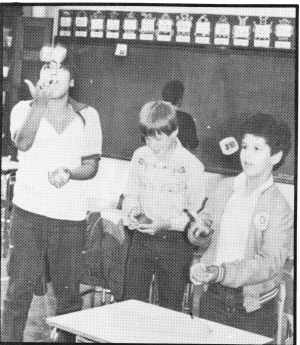
Students (l-r) Richard Castro, Gary Nicolaus and Juan Esteves. |
Page 24 December 1982
|
Through juggling to language arts By
Bill Stone Queens, NY How
was I to keep my special education students at P.S. 91 in Queens, N.Y.,
interested in language arts? I
decided to teach them to juggle!
I
was looking for something to do with my class that would maintain their
attention span and be fun. I had taught myself to juggle in a couple of
hours, and one day demonstrated to them the steps to learning as a
lesson in sequence. They immediately asked if I would teach them how to
do it. "Why not?" I thought.
I
developed and wrote up a program of juggling instruction called
"Juggling, A New Approach to the Language Arts" which entails
reading, writing, motor coordination and performing arts.
It was selected for a grant from Impact II (sponsored by the Board of Education and the Exxon Education Foundation) to be developed into a curriculum for other teachers if they choose to use it.
I
broke the three ball cascade down into individual leaming steps (the
drop, the toss, the three bag practice, the exchange, the three bag
practice no. 2, the first jug and the juggle), listing purpose and goal
for each step.
Students
undertook each step in sequence. After learning to do what was outlined,
they had to write a homework paper describing the step in their own
words, including a description of their feelings and the problems they
encountered. .
Each
paper was dictated the next day in class and written on the blackboard.
l led class discussion about sentence structure, vocabulary and grammar.
The story was edited, corrected and rewritten properly. Each completed
story was then put into a folder. At the end of the program, we held a
book-binding lesson and each child took home a personal diary of his or
her juggling experience. It included art work they had done about
juggling.
We
held discussions about their problems with mastering each step. This
gave them a chance to share their feelings of frustration and
accomplishment. It showed them that mistakes were permissable and that
sharing experiences is a good way to learn.
The
children were anxious to learn each step, and the process became an
effective classroom management technique. I held the juggling session
toward the end of the day, and permitted it only if the rest of the
day's planned work load had been done.
The
program finale was a class performance at "The Special Arts
Festival," held at Columbia University. The most satisfying finale
for me personally, however, was the class performance on the city-wide
reading test --a minimal jump of 2.5 years in each student's score! |

Students (l-r) Richard Castro, Gary Nicolaus and Juan Esteves. |